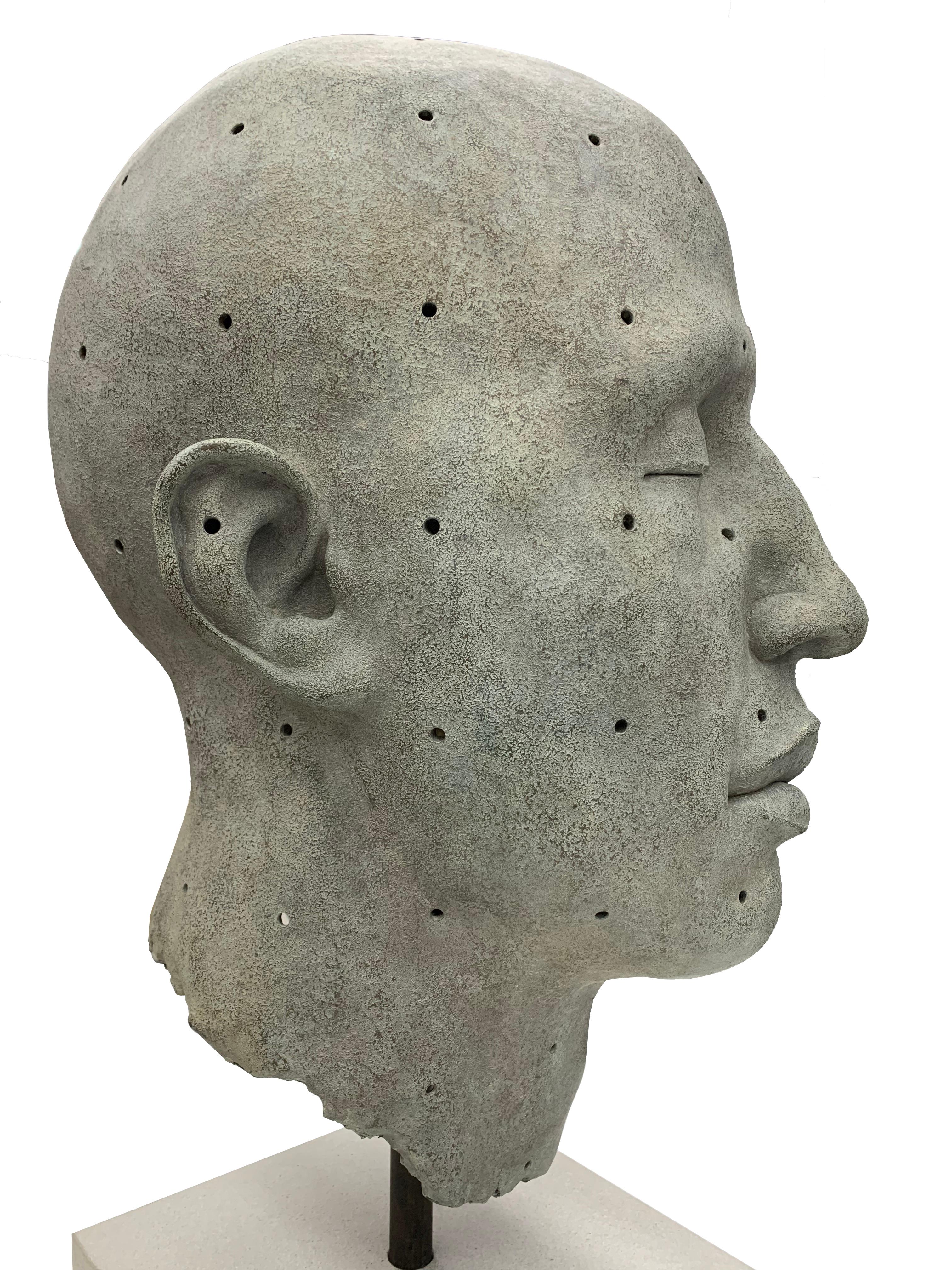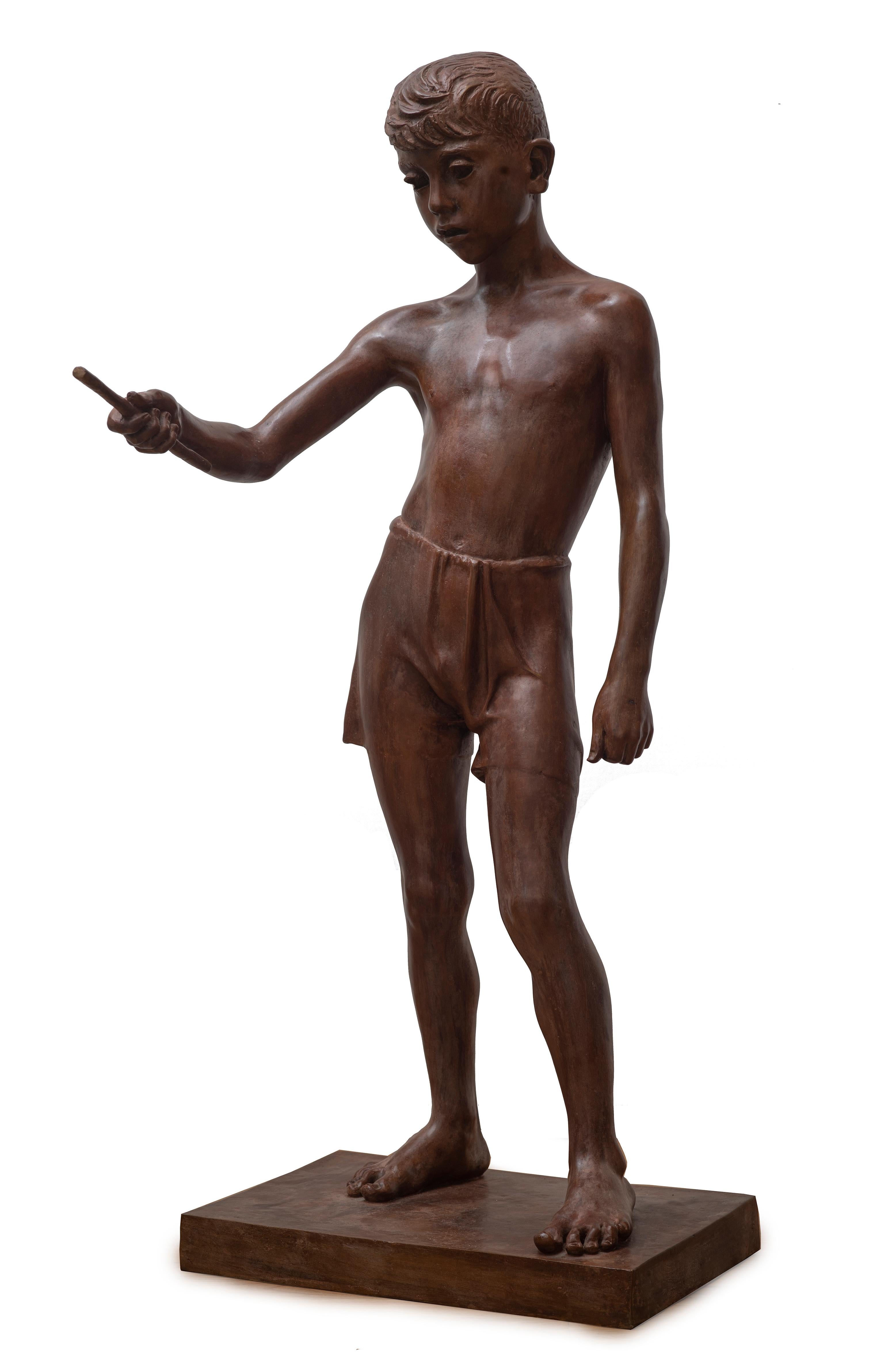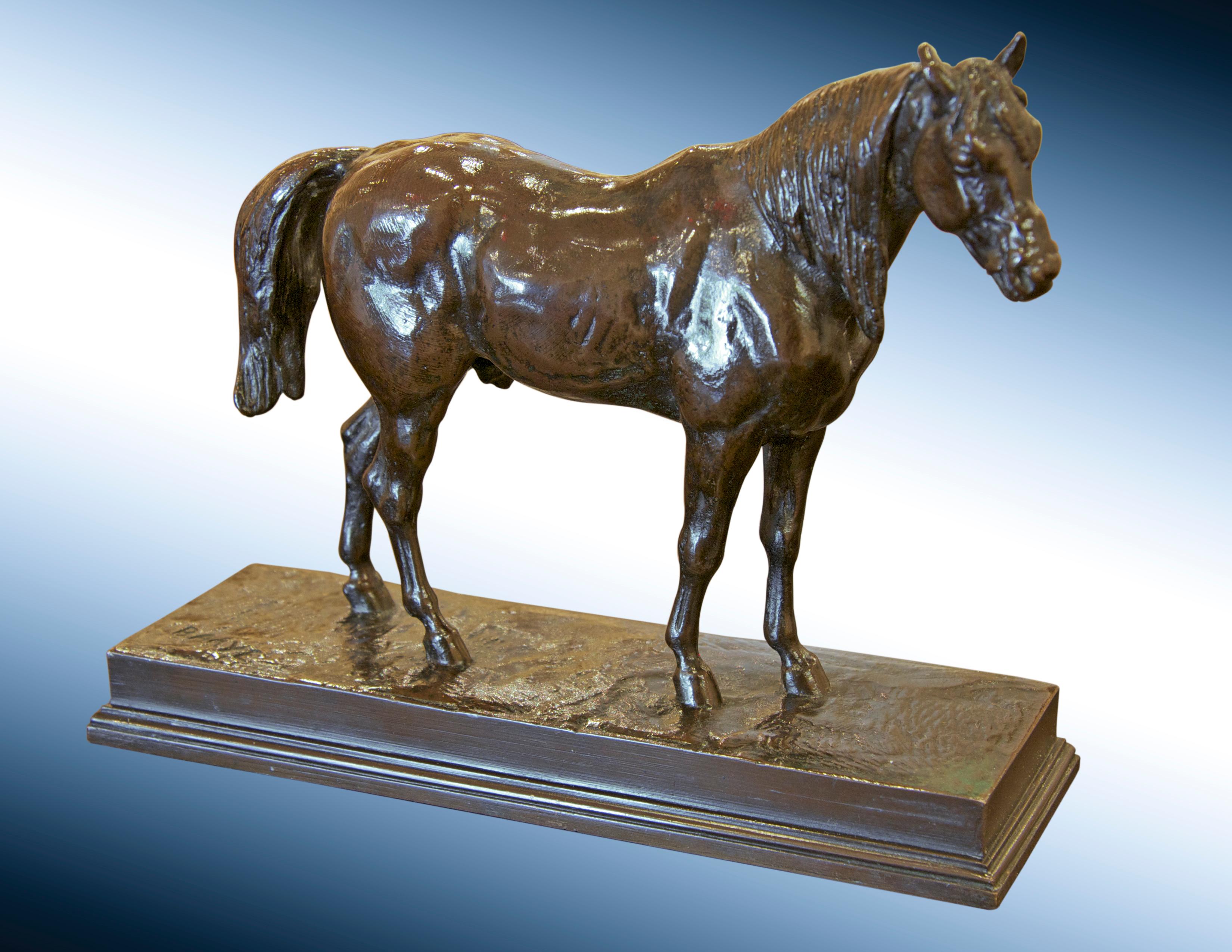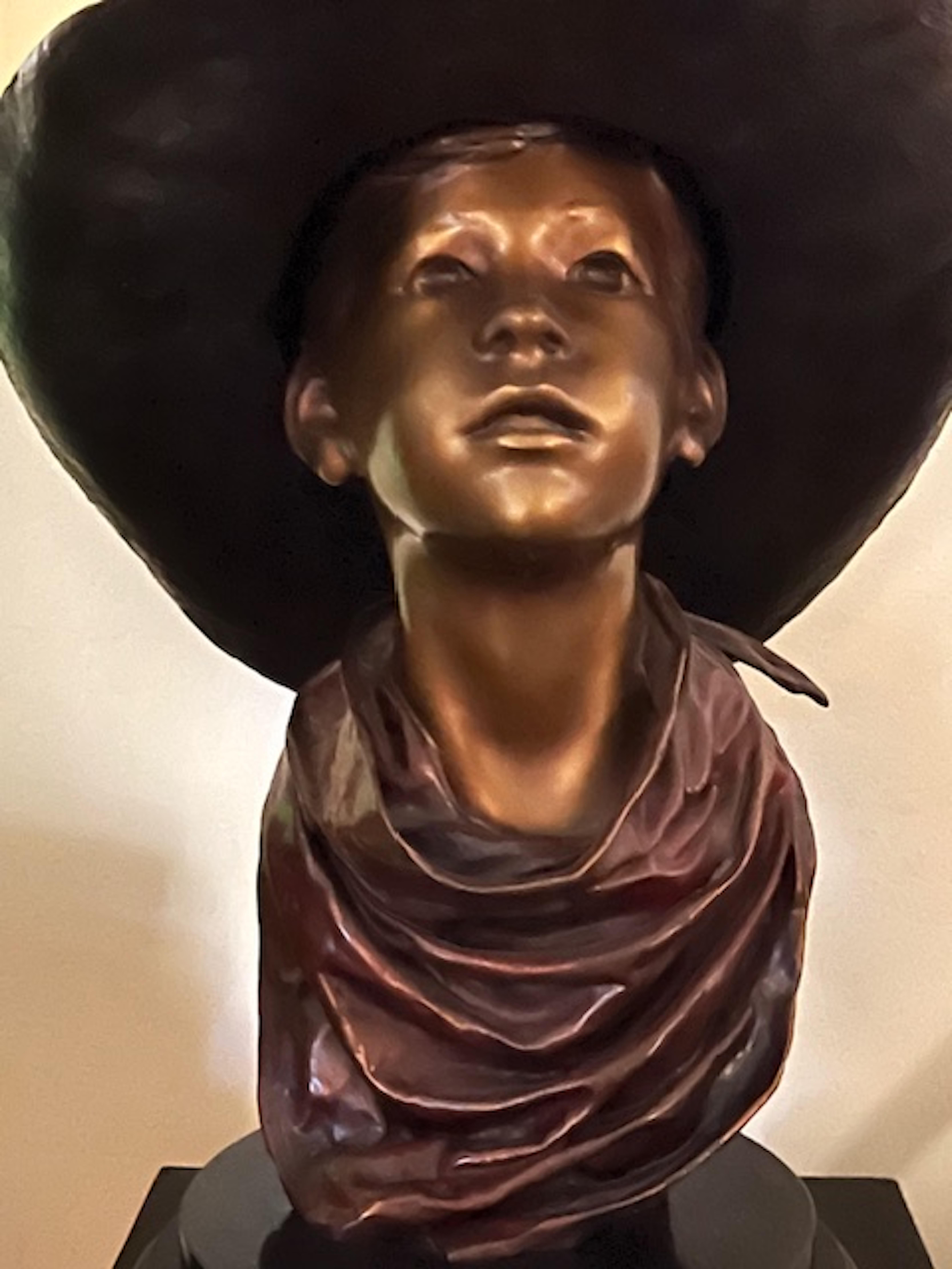Items Similar to Antique: Mare Playing with a Terrier Dog (Good Companions) P. J. Mene 1860
Want more images or videos?
Request additional images or videos from the seller
1 of 15
Pierre-Jules MêneAntique: Mare Playing with a Terrier Dog (Good Companions) P. J. Mene 18601860
1860
About the Item
Antique Horse Bronze: Mare in the Stable Playing with a Dog (Good Companions)
Jument à l'écurie jouant avec un chien
Pierre-Jules Mene (French, 1810-1879)
Bronze
19 x 10 inches
One of Mene's most beloved bronze, well-loved early example with beautiful rich patina. A sensitive portrait of a horse nuzzling his companion while the terrier is giving kisses to the horse’s nose.
Cast by Mene’s own foundry and is very well detailed with a medium brown patina.
Pierre-Jules Mêne (1810-1879) was one of the most successful and prolific animalier sculptors of the 19th century, known for his naturalistic representation of animals.
Mêne received no formal education in sculpture but was taught to draw and model by his father and later began casting his own sculptures. He was largely self-taught, possessing a keen observation of nature that enabled him to capture the essence of his animal subjects with remarkable accuracy and vivacity.
His work debuted at the Paris Salon in 1838, and from that point onwards, he exhibited his sculptures regularly. Mêne specialized in small-scale domestic animals, his subjects often including horses, dogs, bulls, and sheep. Interestingly, almost no big game are found in Mêne's ouevre.
Beginning in 1837 as orders started coming in, Mêne worked as Antoine-Louis Barye before him, opening his own foundry where he personally oversaw the manufacture and production of his art. The work produced there bears the hallmark of extraordinary attention to detail and thoughtfulness shown in every element of presentation and assembly. His mastery in the technical aspects of casting bronze without relying on professional founders for the completion of his models gave him a significant advantage in producing his pieces with fine detail and at a lower cost. This operation was expanded in 1852 to handle the casting of models for his new son-in-law, Auguste Cain.
Mêne’s sculptures are characterized by their naturalistic detail and the sense of immediate and candid snapshots of the animals in their daily lives. The essence of these qualities is captured in the sculpture “The Good Companions” which would become one of his best-known sculpture and clearly was a cherished favorite demanded by his clients.
In the 1850s, Mêne's work gained international fame, and he started receiving commissions from patrons across Europe. His success was such that his sculptures were reproduced widely, in different sizes, and his foundry became one of the most prominent in Paris for animal bronzes. To this end, as an avenue into the profitable English market, he made arrangements with the Coalbrookdale foundry and the Falkirk foundry to cast some of his models.
Mêne’s artistic contributions were recognized with several awards during his lifetime. He was awarded first-class medals at the Expositions Universelles in Paris in 1855, 1861, and 1867, and he was made a Chevalier of the Legion of Honor in 1861.
Mêne's commitment to realism, at a time when the academic tradition still dominated art, was innovative and influential. He is often mentioned alongside artists like Antoine-Louis Barye and Auguste Caïn, who also contributed to the popularity of the animalier school in France.
After a prosperous career, Pierre-Jules Mêne died in Paris on May 20, 1879.
Today, the works of Mêne are held in numerous private collections and museums worldwide, including the Louvre and the Musée d'Orsay in Paris. In terms of reputation, he was second only to the great father of the Animaliers, Antoine-Louis Barye. Mêne remains celebrated for his contributions to French art and the animalier genre, and his sculptures are highly sought after by collectors for their beauty and lifelike quality.
- Creator:Pierre-Jules Mêne (1810 - 1879, French)
- Creation Year:1860
- Dimensions:Height: 10 in (25.4 cm)Width: 19 in (48.26 cm)
- Medium:
- Movement & Style:
- Period:
- Condition:This bronze is in wonderful condition. Part of the reins on side is no longer attached however that's quite common and almost to be expected.
- Gallery Location:SANTA FE, NM
- Reference Number:1stDibs: LU1408213772222
About the Seller
5.0
Platinum Seller
These expertly vetted sellers are 1stDibs' most experienced sellers and are rated highest by our customers.
Established in 1995
1stDibs seller since 2020
90 sales on 1stDibs
Typical response time: 1 hour
- ShippingRetrieving quote...Ships From: Santa Fe, NM
- Return PolicyA return for this item may be initiated within 2 days of delivery.
More From This SellerView All
- Antique Dog: Bulldog Playing with a Mouse- Henri Émile Adrien Trodoux ca. 1870sLocated in SANTA FE, NMAntique Bronze Dog Bulldog Playing with a Mouse on Sheaves of Wheat Henri Émile Adrien Trodoux (1815-1881) 6 1/8 x 3 7/5 inches Signed on the terrace Henri Émile Adrien Trodoux (Fre...Category
Mid-19th Century Realist Figurative Sculptures
MaterialsBronze
- Antique Bronze Portrait Draft Horse by Isidore Jules Bonheur (France, 1827-1901)By Isidore Jules BonheurLocated in SANTA FE, NMAntique Bronze Portrait of a Draft Horse Isidore Jules Bonheur (France, 1827-1901) Circa 1840s Cast bronze mounted on a rectangular plinth atop a marble s...Category
1870s Realist Figurative Sculptures
MaterialsBronze
- Rare, Antique, Life-Size Dog Bronze of a Chihuahua "Lydie" Charles Valton. 1890sBy Charles ValtonLocated in SANTA FE, NMAntique Bronze Dog Sculpture Chihuahua "La Petite Belle Lydie" Charles Valton (French, 1851-1918) Circa 15 1/2 x 10 1/4 x 7 Lydie is a Chihuahua making her a very rare image from ...Category
Late 19th Century Realist Figurative Sculptures
MaterialsBronze
- Antique Horse Bronze Trotting Stallion Isidore Jules Bonheur (France, 1827-1901)By Isidore Jules BonheurLocated in SANTA FE, NMAntique Horse Bronze Portrait of a Trotting Stallion Isidore Jules Bonheur (France, 1827-1901) Cast bronze mounted on a rectangular plinth with dark brown patina, Signed: I. BONHEUR 17 x 11 3/4 A brilliant exploration of a stallion in full trot. The patina is a deep, warm walnut brown with honey-colored tones. Isidore Bonheur was best known and the most distinguished of the 19th century French animalier sculptors. Isidore, the younger brother of Rosa Bonheur and older brother of Auguste, began his studies of painting initially with his father, who was friends with Francisco Goya. By 1848 he debuted at the Paris Salon having discontinued animal and landscape painting to concentrate on creating sculptures and in 1849, Bonheur enrolled at the Ecole des Beaux Arts. He won medals at the Paris Salon in 1859 and did so again in 1865 and in 1869. After entering the Exposition Universelle 1855, he won the Gold Medal in 1889. In the 1870s exhibited in the London at the Royal Academy of Arts where he earned great prestige and won the coveted Medaille d’Or. After winning numerous other medals and prizes, Bonheur was awarded the Legion d' Honneur in 1895 and he was Knighted in Portugal, Spain and France. Bonheur continued exhibiting at the Paris Salon until 1899. Many of his bronzes were fabricated at the foundry owned by Hippolyte Peyrol, Bonheur's brother-in-law by marriage to Isidore’s youngest sister Juliette Bonheur. The Peyrol casts for both Rosa and Isidore are exceptionally well executed which suggests a strong working relationship between the founder and sculptor. There is little doubt that Isidore Bonheur was an acute observer of nature; his animals were not anthropomorphized but modelled to catch movement or posture characteristics of the particular species he was sculpting. He achieved this most successfully with his sculptures of horses which are usually depicted as relaxed rather than spirited. These figures are among his most renowned works and his equestrian models became very popular, particularly among the British aristocracy. An acute observer of nature, his sculptures reflect his commitment to the Realist school - with precise detailing of the movements of animals in their natural habitats. Ultimately, His naturalistic studies of animals are now some of the most highly sought after works by any of the animalier. He was possibly inspired by his many visits to the Buffalo Bill Wild West Show...Category
1870s Realist Figurative Sculptures
MaterialsBronze
- Antique Exceptional Bronze Draft Horse by Pierre Jules Mêne (French, 1810-1879)Located in SANTA FE, NMAntique Horse Bronze Exceptional Bronze of a Draft Horse Pierre Jules Mêne (French, 1810-1879) Circa 1860s 4 3/4 (W) x 3.25 (H) As Mêne personally ov...Category
Mid-19th Century Romantic Figurative Sculptures
MaterialsBronze
- Antique 19th century Bronze Dog Portrait of a Maltese on a Marble BaseLocated in SANTA FE, NMAntique Bronze Dog Portrait of a Maltese on a Marble Base French 19th century 1/2 x 8 x 5 1/2 inches The chiseled bronze has a nuanced, rich brown patina depicting a Maltese in the round, seated on a quadrangular marble base decorated with very fine gilt bronze flowers and fluted feet. Napoleon III, Louis XVI style. Based on a model by Jacques Caffieri for the Prince de Condé in 1773. (More images to be added.) Executed during the nineteenth century, this figure is fully in line with the eclectic taste of the reign of Napoleon III. Indeed, the Empress Eugenie brought the Louis XVI style up to date in her castle of Compiègne. Jacques Caffieri is one of the most famous bronze smiths of the eighteenth century. In 1715 he was admitted as a master caster and chiseler, and worked almost exclusively for the crown castles...Category
19th Century Rococo Figurative Sculptures
MaterialsMarble, Bronze
You May Also Like
- James Mathison, Cabeza grande con huecos, 2011, Bronze, 76 x 50 x 57 cmLocated in Miami, FLJames Mathison Cabeza grande con huecos, 2011 Bronze 76 x 50 x 57 cm 29.9 x 19.6 x 22.4 in. Following the humanist tradition of sculpture, Mathison creates from diminutive to large scale pieces assessing the character, nature and qualities of different parts of the male figure and ascertaining his exact size and proportions with the use of solid materials, to render expressive and emotional works. "Having explored the visual and practical use of resin and bronze, Mathison registers his signature mark that as imprints or fingerprints, show that the passage of time has left on its surface," said Venezuelan art...Category
2010s Realist Figurative Sculptures
MaterialsBronze
- FishermanBy Francesco MessinaLocated in Roma, RMFrancesco Messina (Linguaglossa 1900 – Milan 1995), Fisherman (1930) Bronze sculpture measuring 131 x 52 x 65 cm, signed and dated 1930 on the base. Francesco Messina’s Fisherman w...Category
1930s Realist Figurative Sculptures
MaterialsBronze
- Le cheval demi-sang arabeBy Antoine-Louis BaryeLocated in Washington, DCA nineteenth-century cast of Antoine-Louis Barye's Le cheval demi-sang arabe (no. A125-Poletti; A148-Pivar), with nice patina. Poletti and Richarme, Barye: Catalogue raisonné des sc...Category
Late 19th Century Realist Figurative Sculptures
MaterialsBronze
- BANDANABy W Stanley ProctorLocated in Tallahassee, FLYoung Cowboy with Hat & Bandana. Part of Artist's Personal Collection.Category
20th Century Realist Figurative Sculptures
MaterialsBronze
- REMINGTONBy W Stanley ProctorLocated in Tallahassee, FLHas been in artist's private collection. Maquette hunting dog with training dummy.Category
21st Century and Contemporary Realist Figurative Sculptures
MaterialsBronze
- LULLABYBy W Stanley ProctorLocated in Tallahassee, FLHas been in artist's private collection. Young girl with bow in her hair holding her favorite toy.Category
20th Century Realist Figurative Sculptures
MaterialsBronze




